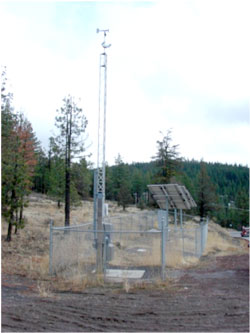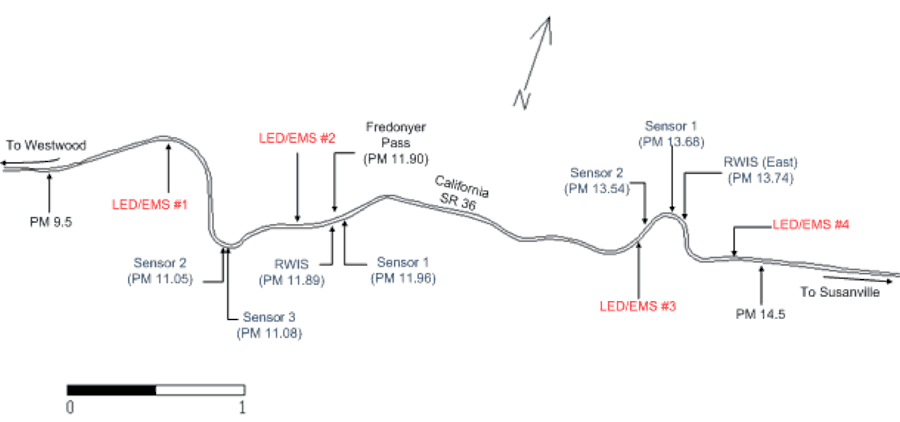Best Practices for Road Weather Management
California DOT Icy Curve Warning System
Fredonyer Pass, located in northeastern California, is a five-mile segment of State Highway 36 in Lassen County that has a history as a high-collision location, including multiple fatal crashes involving local residents. The vast majority of these crashes (note in this document, the terms crash and collision may be used interchangeably) occurred when the pavement was icy, despite static signage that the California Department of Transportation (Caltrans) had installed to increase motorist awareness.
To address this, Caltrans deployed a system consisting of pavement sensors to detect icy conditions, in combination with dynamically activated signage to provide motorists with real-time warning when icy conditions are either imminent or present. The intention of the system was to use real-time messaging to increase motorist vigilance and reduce the number of crashes occurring during icy pavement conditions. The system consists of pavement sensors to detect icy conditions, in combination with dynamically activated signage to provide motorists with real-time warning when icy conditions are either imminent or present. It alerts motorists of icy conditions, eliciting a decrease in vehicle speeds during such conditions. Consequently, lower vehicle speeds are expected to translate to reduced crashes along the length of the curves which have presented safety challenges in the past.
System Components: Each system consists of a Road Weather Information System (RWIS) with roadway sensors and two Extinguishable Message Signs (EMS) with flashing beacons. Specialized scripts are executed in the RWIS Remote Processing Unit (RPU) that evaluate the status of the roadway sensors and determine when the ice warning should be active. A signal from the RPU then turns on the warning signs. At the summit system, a Closed Circuit Television (CCTV) camera is also present to allow the TMC in Redding to monitor conditions at the pass.
System Operations: This system is collectively known as the Fredonyer Pass Icy Curve Warning System (ICWS). It is comprised of two similar but separate warning systems: Fredonyer Summit ICWS and Fredonyer East ICWS. The technologies employed in each system include a RWIS, which continuously monitors the road surface condition and identifies when icy or packed snow conditions are present; and two EMS, which provide dynamic warnings to motorists when icy or packed snow conditions are present.
One RWIS is placed in the heart of each curve at a location determined by to experience icing conditions most frequently. One EMS was placed on the approaches to each curve at a location to provide adequate braking distance for vehicles headed into an icy curve.
A schematic showing the location of the Intelligent Transportation Systems (ITS) elements of the system is presented in Figure CA-3.
Figure CA-3. Schematic of Fredonyer Pass and Icy Curve Warning System.
The original, vendor-supplied system components were installed during the summer of 2002, including RWIS pavement sensors, RWIS towers, solar panels, and EMS. Over time however, it became evident that this system would not reliably operate in the manner envisioned by Caltrans. Instead, the system was rebuilt by Caltrans District 2 ITS Engineering and highway maintenance personnel. Ice detection optimization continued for about two seasons after the hardware was corrected.
Transportation Outcome(s): In order to determine the safety effects of the ICWS, an observational before-after study using the Empirical Bayes technique was employed. This evaluation determined the effect of ICWS on crash frequencies. The results found that the deployment of the ICWS reduced the number of annual crashes by 18%. As no other changes occurred along the study segment (additional safety improvements, geometric changes, etc.), it is reasonable to attribute this observed safety improvement to the ICWS. Additionally, a crash rate method was used to investigate the effect of the ICWS on crash severities, with a focus on ice-related accidents. The results indicated that the ICWS has reduced crash severities. As an outcome of reduced crash severities, the system was estimated to provide safety benefits of $1.7 million dollars per winter season during the after deployment study period (2008-2009, on account of time lag in crash data availability). Given that 1.5 years of after-period data was available for analysis, it would be advisable to revisit the safety performance of the Fredonyer ICWS at some point in the future when more years of crash data are available. Overall however, the initial safety evaluation results indicate that the system is having a positive impact on reducing crashes.
From the perspective of winter maintenance personnel, the ICWS is an improvement over typical static metal signage. Observations made over time have indicated that as the winter progresses, the system works better. The use of additional pavement sensors for detection of conditions in multiple lanes could improve system accuracy and reliability. The data produced by the ICWS is not presently employed by maintenance forces for any activity, although the CCTV camera associated with the system’s RWIS at the summit is used frequently to obtain visual information on present conditions.
The ICWS’s in District 2 are the only focused pavement section ice detection and warning systems that have been successfully deployed and function properly. While the results are preliminary while data collection is ongoing, there may be a real and significant safety improvement and improvement in driver behavior due to the systems’ presence. Traditionally, these types of problem areas required an expensive roadway realignment to solve reoccurring icing. Deployment of ICWS systems may allow for an interim, lower cost option that provides a safety benefit until funds for a full realignment can be secured.
Implementation Issues: The ICWS was not considered fully operational and reliable until the winter season of 2008-2009. Following, an evaluation of the performance of the ICWS focusing on the metrics of speed reduction under various conditions and safety performance through crash reduction was conducted. The results of the statistical analysis of speed data suggest that the system is working as intended and that vehicle speeds are significantly lower. As one would expect, mean speeds were lower when the system was turned on versus off as well as during the day and at night. When general wet weather (snow, rain, etc.) conditions were evaluated, it was found that mean speeds were reduced when the system was on versus off during both the day and at night. The real effectiveness of the Fredonyer ICWS on vehicle speeds is its impact during clear, cold and not dry conditions, when snow melting or general water/ice pooling from the wet and cold environment of the curve locations may produce runoff across the roadway in the target curve and result in ice formation. Mean speed differences exceeding 3 mph were observed during such conditions during both the day and at night at a majority of sites. However, only a limited number of mean speed differences were found to be greater than 5 mph. As the speed readings employed in this evaluation were collected at sign locations in advance of the curves of interest/concern targeted by the ICWS, it is possible that the observed changes in mean speeds reported here are translating into even more significant reductions by motorists as they enter and traverse each curve. When examining different levels of manned chain control versus the system state and time of day, it appears that the greatest impact of the ICWS is when R-1 control is in effect. (R-1 control is a requirement for chains on tires of commercial vehicles, and snow tread tires or chains on all other vehicles.)
Feedback by Intelligent Transportation Systems (ITS) engineering indicated that following the rebuilding of the ICWS, it is generally functioning as expected. However, observations over several years of operation have indicated that the system has difficulty identifying road conditions during the early winter. The use of additional sensors in such cases would address this issue. Also, employing data from supplemental sensors (such as air temperature, precipitation, et cetera.) could possibly allow the system to compensate for times that roadway surface temperature and condition data is not sufficient in identifying potential icing conditions. When considering similar systems for deployment elsewhere, it is especially important to select roadway sensors that can be tested and calibrated easily, and to employ data collection equipment in the system that uses open and easily programmed software.
Finally, feedback provided by the California Highway Patrol (CHP) indicated that drivers appear to be slowing down when the ICWS is on (particularly in vicinity of the targeted curves). This is only perception though, and there has been no analysis performed by CHP (on ticket records, for example) to verify whether it is in fact the case. It was also believed that crashes over the pass have dropped in recent years although, again, no analysis of data has been performed to confirm this view. The thoughts of CHP on this drop were that it could be related to the ICWS, as well as manned chain control policies employed by Caltrans. In general, the system appears to be accurate in indicating ice conditions.
Contact(s):
- For system information:
Ian Turnbull, P.E., Chief, Office of ITS Engineering and Support, Caltrans, District 2, 1657 Riverside Drive, M/S 14, Redding, California 96001.
- For evaluation information:
David Veneziano, Ph.D., Research Scientist, Western Transportation Institute, Montana State University, PO Box 174250, Bozeman, Montana 59717-4250.
Reference(s):
- Rama, P., and Luoma, J., “Driver Acceptance of Weather-Controlled Road Signs and Displays,” Transportation Research Record 1573, Transportation Research Board, National Research Council, Washington [DC] (1997), pp. 72-75.
- Carson, J., and F. Mannering. The Effect of Ice Warning Signs on Ice-Accident Frequencies and Severities. Accident Analysis and Prevention, 33(1), 2001.
- Hauer, E. Observational Before-After Studies in Road Safety: Estimating the Effect of Highway and Traffic Engineering Measures on Road Safety.
- Pergamon Press/Elsevier Science Ltd, Oxford, England, 1997.
- Federal Highway Administration. Motor Vehicle Accident Costs. U.S. Department of Transportation, Washington, DC, October 1994.
- Bureau of Labor Statistics. CPI Inflation Calculator. (Accessed on March 20, 2011).
Keywords: Icy, Ice, Ice Detection, Automated Warning, Safety, Performance, Weather, Visibility, Wireless, Solar Power.
previous | next
